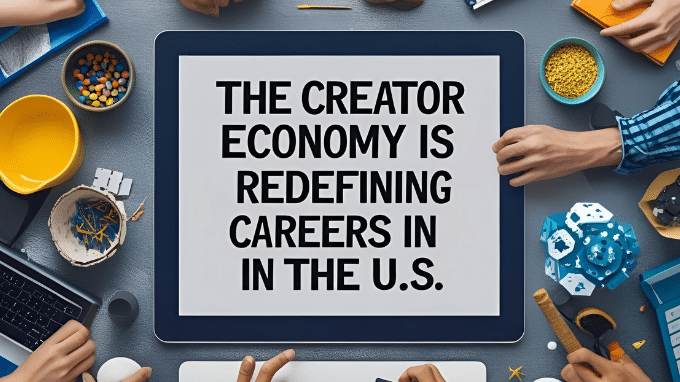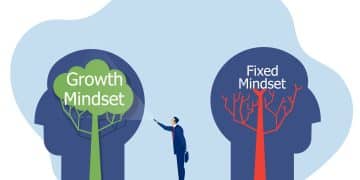The Creator Economy Is Redefining Careers In The U.S.

In 2025, the idea of what it means to have a “real job” has changed—and chances are, you’ve already noticed. Scroll through TikTok or open YouTube, and you’ll find creators sharing career tips, running digital businesses, and making real money doing things that didn’t even exist as job titles a few years ago. From online educators and newsletter writers to tech YouTubers and lifestyle podcasters, people across the U.S. are discovering new ways to earn a living that feel more flexible, more personal, and sometimes, more rewarding.
But this isn’t just a trend. The creator economy has evolved into a full-blown movement—reshaping not just how people make money, but how they think about work itself. The traditional 9-to-5 model? It’s not going anywhere, but it’s no longer the only option. People are blending careers, launching side projects, and building brands around their personalities and passions.
In this article, we’ll explore:
- How the creator economy 2025 is shifting full-time employment norms
- Key side hustle trends 2025 influencing how Americans earn on the side
- What the future of work in the U.S. looks like across industries
- How traditional career paths are adapting to this new, creative model
- What it all means if you’re thinking about trying something different
What’s Changed? A Closer Look at the Creator Economy

Once upon a time, being a “content creator” wasn’t considered a real job. Now? Millions of Americans are doing it—full-time, part-time, or on the side. The creator economy includes everyone from fitness coaches posting on Instagram to graphic designers selling templates on Etsy. What they all have in common is this: they’re using digital platforms to share value and earn directly from their audience.
So what’s fueling the growth of the creator economy?
- Short-form video content is booming, especially on TikTok, Reels, and Shorts
- Tools like Patreon, Substack, and Gumroad make it easier than ever to monetize
- AI has simplified content creation and leveled the playing field
- People are craving work that feels less corporate and more personal
- Audiences connect more with authenticity than polish
Bottom line? The creator economy 2025 isn’t about chasing fame. It’s about building trust, creating useful content, and finding your niche.
Read next: Top 10 Highest-Paying Jobs In 2025: Earn $200K With These Career Paths!
How the Creator Economy Is Changing Careers—and Who’s Tuning In
1. There’s No One-Size-Fits-All Path Anymore
The old-school career blueprint—get a degree, climb the ladder, retire at 65—is outdated. People are mixing roles, exploring multiple income streams, and changing directions mid-career. Someone might work in finance during the day and run a successful knitting channel on YouTube at night. That’s not side hustle chaos—it’s modern career design.
2. Employers Are Hiring Creators
Believe it or not, personal brands matter. Companies are paying attention to who’s building influence, sharing thought leadership, and connecting with audiences online. Whether you run a niche blog, publish how-to videos, or host a podcast—those things can help you land a job.
Creators are now stepping into roles like:
- Brand manager
- Creative strategist
- Community lead
- Marketing consultant
It’s a shift in how companies think about talent. Having a personal brand isn’t a distraction anymore—it’s an asset.
3. Proof Matters More Than Paper
Degrees are still valuable. But if you’ve built a successful newsletter or grown an engaged following, you’re proving your skills in real time. Employers—and clients—are more interested in what you can do than where you went to school.
This shift is at the core of how the creator economy is changing careers in 2025: it’s less about credentials and more about showing up and delivering results.
Side Hustle Trends 2025: Creators On the Side
Not everyone wants to quit their job and go full-time into content. In fact, most people start small. The side hustle scene is thriving—and creators are at the center of it.
According to recent surveys, nearly half of U.S. workers now have a side hustle. These include:
- Selling digital products or templates
- Launching niche blogs or newsletters
- Posting tutorials or educational content on TikTok or YouTube
- Freelancing in writing, design, or video editing
- Running courses or offering coaching in a specialty area
These aren’t just passion projects—they’re strategic ways to build income and test ideas. The best part? You don’t have to choose between a paycheck and creativity. You can have both.
As side hustle trends 2025 show, more people are opting in—not because they have to, but because they want to explore what else is possible.
How Traditional Careers Are Keeping Up
Employers know they need to change to keep talent. And many are stepping up:
- Remote-first policies are here to stay, giving people more control over their time
- Job descriptions are evolving, allowing employees to flex skills across roles
- Personal branding is encouraged, not discouraged
It’s all part of the shifting future of work in the U.S. Employees want meaning, not just money. And companies that support side hustles, creativity, and flexibility? They’re attracting the best talent.
Read next: How to Negotiate Your Salary in 7 Strategic Steps: Get The Salary You Deserve
Should You Try the Creator Economy?
Let’s keep it real: being a creator isn’t a guaranteed path to success. But it is a way to build something of your own—and maybe even change your life in the process. Whether you’re an accountant who wants to write, a nurse who wants to teach on YouTube, or a manager who just loves designing templates, there’s room for you.
Here’s what people love:
- Freedom to create and choose your projects
- The ability to work on your own schedule
- Building income around your interests
- Creating something meaningful that’s yours to keep
And what they don’t always talk about:
- It takes time and consistency to grow
- You’re responsible for marketing, content, admin, and more
- There’s no guaranteed paycheck
- It’s easy to burn out if you try to do too much, too fast
Still, the barrier to entry is low—and the upside is huge. You don’t have to go viral. You just have to be useful, honest, and willing to learn.
Getting Started (Without Quitting Your Job)
No need to go all in from day one. Start small:
- Share helpful content on LinkedIn
- Publish a free guide or mini course
- Record a short video with your take on something you know well
- Repurpose your work experience into something teachable or shareable
The creator economy 2025 rewards people who show up. You don’t need fancy equipment or a 10-step plan. You just need to start with what you have.
Read next: Step-By-Step Guide On How To Land A High-Paying Remote Job In 2025
A New Way to Work
The creator economy isn’t coming—it’s already here. It’s transforming how people earn, learn, and connect. Whether you’re building a side hustle, freelancing, or blending content with your career, you’re part of something bigger.
So, how is the creator economy changing careers in the U.S.? It’s giving people more choices, more freedom, and more ownership. That’s a future worth stepping into.
Whatever your next move is—just remember, you don’t need a perfect plan. You just need a reason to begin.





